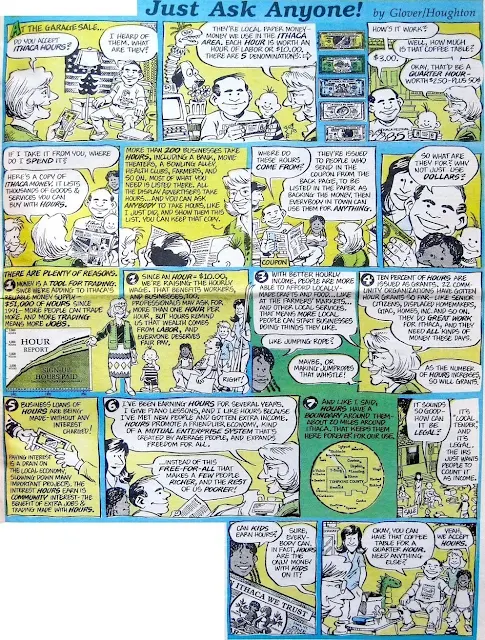That the money in your bank account is not cash at all, not pieces of paper sitting in a bank vault waiting for you to withdraw them, but mere digital ones and zeros in the bank’s database, capable of being subtracted from your account at a moment’s notice, or even less. Cash that is not in your hand, it turns out, is not cash at all.
This should be reason to give pause
for thought about some of the deeper issues behind our current international
financial order: what is money, after all, if it is not physical pieces of
paper that we keep in our wallet?
And if we don’t control it, who does?
As opposed to this system of
financial control by a few bankers, heading as it is toward a seemingly
inevitable financial collapse that threatens to crash the entire world economy,
there are many alternate ideas for facilitating transactions.
Some advocate for a gold-backed
system, or some other hard asset backed currency that protects against rampant
government printing and the possibility of hyperinflation.
Others tout debt-free
government-issued money, spent into the economy on infrastructure and other
tangible benefits to the community and kept in check through taxation or
demurrage.
Yet others believe the answer lies
in more technological solutions, pointing to the recent success of the online
crypto-currency Bitcoin as an example of a different way to think about money.
While there are merits and demerits
to all of these systems, it is vital that we realize the issue of monetary
reform is not constrained to hoped-for changes to our current system that will
possibly be implemented one day in the future in all-at-once changeover.
Please enlarge thumb.
In fact, there exists right now the globe examples of alternative currencies that are currently existing alongside the Federal Reserve notes and Euros and other bankster-manipulated debt-based fiat money systems that are already helping facilitate transactions and grow local economies all around the globe. [See this and this and this and this and this.]
These alternative systems do not
require a resolution to be passed in congress or parliament, and do not require
any wholesale change in the international financial order.
These currencies already exist and
are already thriving in numerous localities around the globe. Referred to as
complementary currencies, they provide a way for communities to bypass the
inflation tax and arbitrary confiscation that defines the modern era of
central-bank administered currency.
Just as the fiat money printed up by
these central banks (or issued as debt in the form of back loans) are backed up
by the collateral of the people’s promise to pay later through the sweat of
their own labour, so too can these complementary currencies be issued through
the people’s own labour. The difference being that in this system, the money is
not controlled by banksters in closed door meetings in faraway offices, but by
the people themselves, in their own back yards.
One example of a complementary
currency success story is the Ithaca
Hours currency issued in Ithaca, New York. Launched in 1991
as a way to invigorate the local economy, Ithaca Hours have since facilitated
millions of dollars in transactions and helped businesses and customers alike
bypass the uncertainties of the Federal Reserve notes of the central banking
economy.
Earlier this week I talked to Paul Glover, developer of the Ithaca
Hours system, about the project, and how it has transformed the local economy
of Ithaca.
Now, similar ideas are springing up
all across America and around the globe. From mutual credit systems to time
banking to private currencies and social currencies, there is no shortage of
ideas for how to transition off of the current system in a gradual manner while
increasing and facilitating local trade.
Last month, I had the chance to talk to Wayne
Walton, one of the organizers behind the Colorado
Mountain Hours complementary currency, about this idea, and
how it is being implemented in the Summit County area.
As with so many other ideas for
resistance of the status quo, the complementary currency
Sadly, the comfortable inertia that
the status quo offers is enough to keep many from even entertaining the idea of
using a different form of money. But as the people in Volos, Greece and other
cash-strapped locations around the globe are finding, having an established
complementary currency can help a community survive and even thrive in the
midst of the economic chaos that we can all see coming.
Please enlarge thumb
Just as currencies like Ithaca Hours and Mountain Hours have proven themselves to be successful, so have many complementary currencies withered away from lack of community support.
But in this age of Cyprus-style
bail-ins, debt ceiling crises, and the ever-looming risk of hyperinflationary
currency death spirals, it is incumbent on all of us to identify and support,
or even create, a complementary currency system in our own local area.



I admit to having not yet heard of Ithaca Hours (or Mtn. Hours) so I really appreciate you providing a brief overview here esp. as it is a simple and concise way to share the info with others.
ReplyDeleteI haven't spent much time yet researching alternative currencies but what little I have seen leaves me thinking a true 'Social Credit' styled scheme is likely the best option to replace any nation's phony currency. But that's way down the road (seemingly). Any localized options such as Trading Hours is a step in the right direction, esp. as it takes both the government's and the banker's dirty hands out of the equations.